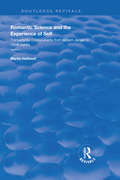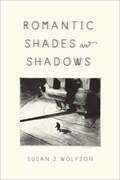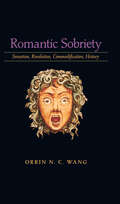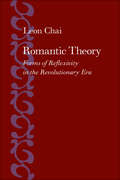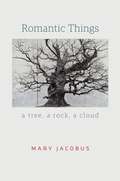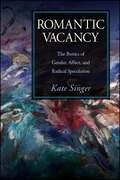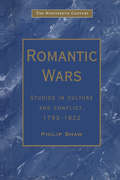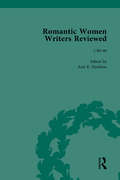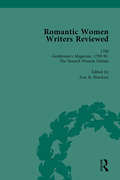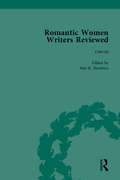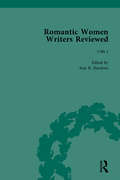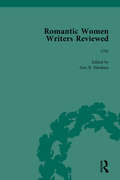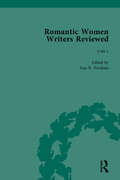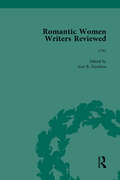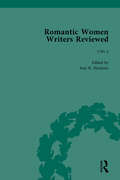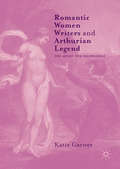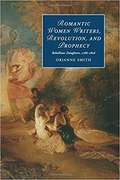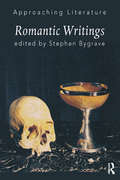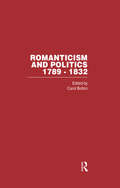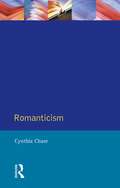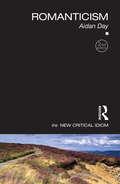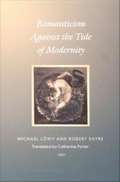- Table View
- List View
Romantic Science and the Experience of Self: Transatlantic Crosscurrents from William James to Oliver Sacks (Routledge Revivals #Vol. 2)
by Martin HalliwellFirst published in 1999, this volume follows the work of five influential figures in twentieth-century transatlantic intellectual history. The work forms the basis for this engaging interdisciplinary study of romantic science. In this book, Martin Halliwell constructs a tradition of romantic science by indicating points of theoretical intersection in the thought of William James (American philosopher); Otto Rank (Austrian psychoanalyst); Erik Erikson (Danish/German psychologist); and Oliver Sacks (British neurologist). Beginning with the ferment of intellectual activity in late eighteenth-century German Romanticism, Halliwell argues that only with William James’ theory of pragmatism early in the twentieth century did romantic science become a viable counter-tradition to strictly empirical science. Stimulated by recent debates over rival models of consciousness and renewed interest in theories of the self, Halliwell reveals that in their challenge to Freud’s adoption of ideas from nineteenth-century natural science, these thinkers have enlarged the possibilities of romantic science for bridging the perceived gulf between the arts and sciences.
Romantic Shades and Shadows
by Susan J. WolfsonHaunting’s consequences for the literary imagination.Reading is a weirdly phantasmic trade: animating words to revive absent voices, rehearing the past, fantasizing a future. In Romantic Shades and Shadows, Susan J. Wolfson explores spectral language, formations, and sensations, defining an apparitional poetics in the finely grained textures of writing and their effects on present reading. Framed by an introductory chapter on writing and apparition and an afterword on haunted reading, the book includes chapters of sustained, revelatory close attention to the particular, often peculiar, literary imaginations of William Wordsworth, William Hazlitt, Percy Bysshe Shelley, Lord Byron, W. B. Yeats, and John Keats. Wolfson also explores the work of Samuel Taylor Coleridge (a self-confessed Ghost-Theorist), Mary Shelley, and other writers of the Long Romantic era, canonical as well as less familiar. All are encountered in freshly pointed ways on an arc of investigation that builds with generative force.Romantic Shades and Shadows is written with a lucidity, wit, and accessibility that will appeal to general readers, and with a critical sophistication and scholarly expertise that will engage advanced students, critics, and professional peers.
Romantic Sobriety: Sensation, Revolution, Commodification, History
by Orrin N. WangWinner, 2011 Jean-Pierre Barricelli Prize, International Conference on RomanticismThis book explores the relationship among Romanticism, deconstruction, and Marxism by examining tropes of sensation and sobriety in a set of exemplary texts from Romantic literature and contemporary literary theory.Orrin N. C. Wang explains how themes of sensation and sobriety, along with Marxist-related ideas of revolution and commodification, set the terms of narrative surrounding the history of Romanticism as a movement. The book is both polemical and critical, engaging in debates with modern thinkers such as Paul de Man, Jacques Derrida, Walter Benn Michaels, and Slavoj Žižek, as well as presenting fresh readings of late eighteenth- and early nineteenth-century writers, including Wordsworth, Kant, Shelley, Byron, Brontë, and Keats. Romantic Sobriety combines deeply complex, close readings with a broader reflection on Romanticism and its implications for literary study. It will interest scholars who study Romanticism from a number of perspectives, including those interested in bodily and social consumption, the roles of addiction and abstinence in literature, the connection between literary and visual culture, the intersection of critical theory and Romanticism, and the relationships among language, historical knowledge, and political practice.
Romantic Theory: Forms of Reflexivity in the Revolutionary Era
by Leon ChaiWinner of the Jean-Pierre Barricelli Prize given by the International Conference on RomanticismThis original study explores the new idea of theory that emerged in the wake of the French Revolution. Leon Chai sees in the Romantic age a significant movement across several broad fields of intellectual endeavor, from theoretical concepts to an attempt to understand how they arise. He contends that this movement led to a spatial treatment of concepts, the primacy of development over concepts, and the creation of metatheory, or the formal analysis of theory. Chai begins with P. B. Shelley on the need for conceptual framework, or theory. He then considers how Friedrich Wolf and Friedrich Schlegel shift from a preoccupation with antiquity to a heightened self-awareness of Romantic nostalgia for that lost past. He finds a similar reflexivity in Napoleon's battle plan at Jena and, subsequently, in Hegel's move from substance to subject. Chai then turns to the sciences: Xavier Bichat's rejection of the idea of a unitary vital principle for life as process; the chemical theory of matter developed by Humphry Davy; and the work of Évariste Galois, whose proof of the solvability of equations using radicals ushered in the age of metatheory. Chai concludes with reactions to theory: Coleridge's proposal of the conflict between reason and understanding as a model of theory, Mary Shelley's effort to replace theory with a different kind of relationship to external others, and Hölderlin's reflection on the limits of representation and the possibility of fulfillment beyond it.
Romantic Things: A Tree, A Rock, A Cloud
by Mary JacobusOur thoughts are shaped as much by what things make of us as by what we make of them. Lyric poetry is especially concerned with things and their relationship to thought, sense, and understanding. In Romantic Things, Mary Jacobus explores the world of objects and phenomena in nature as expressed in Romantic poetry alongside the theme of sentience and sensory deprivation in literature and art. Jacobus discusses objects and attributes that test our perceptions and preoccupy both Romantic poetry and modern philosophy. John Clare, John Constable, Rainer Maria Rilke, W. G. Sebald, and Gerhard Richter make appearances around the central figure of William Wordsworth as Jacobus explores trees, rocks, clouds, breath, sleep, deafness, and blindness in their work. While she thinks through these things, she is assisted by the writings of Maurice Merleau-Ponty, Jacques Derrida, and Jean-Luc Nancy. Helping us think more deeply about things that are at once visible and invisible, seen and unseen, felt and unfeeling, Romantic Things opens our eyes to what has been previously overlooked in lyric and Romantic poetry.
Romantic Things: a tree, a rock, a cloud
by Mary JacobusOur thoughts are shaped as much by what things make of us as by what we make of them. Lyric poetry is especially concerned with things and their relationship to thought, sense, and understanding. In Romantic Things, Mary Jacobus explores the world of objects and phenomena in nature as expressed in Romantic poetry alongside the theme of sentience and sensory deprivation in literature and art. Jacobus discusses objects and attributes that test our perceptions and preoccupy both Romantic poetry and modern philosophy. John Clare, John Constable, Rainer Maria Rilke, W. G. Sebald, and Gerhard Richter make appearances around the central figure of William Wordsworth as Jacobus explores trees, rocks, clouds, breath, sleep, deafness, and blindness in their work. While she thinks through these things, she is assisted by the writings of Maurice Merleau-Ponty, Jacques Derrida, and Jean-Luc Nancy. Helping us think more deeply about things that are at once visible and invisible, seen and unseen, felt and unfeeling, Romantic Things opens our eyes to what has been previously overlooked in lyric and Romantic poetry.
Romantic Tragedies
by Reeve ParkerTroubled politically and personally, Wordsworth and Coleridge turned in 1797 to the London stage. Their tragedies, The Borderers and Osorio, were set in medieval Britain and early modern Spain to avoid the Lord Chamberlain's censorship. Drury Lane rejected both, but fifteen years later, Coleridge's revision, Remorse, had spectacular success there, inspiring Shelley's 1819 Roman tragedy, The Cenci, aimed for Covent Garden. Reeve Parker makes a striking case for the power of these intertwined works, written against British hostility to French republican liberties and Regency repression of home-grown agitation. Covertly, Remorse and The Cenci also turn against Wordsworth. Stressing the significance of subtly repeated imagery and resonances with Virgil, Shakespeare, Racine, Jean-François Ducis and Schiller, Parker's close readings, which are boldly imaginative and decidedly untoward, argue that at the heart of these tragedies lie powerful dramatic uncertainties driven by unstable passions - what he calls, adapting Coleridge's phrase for sorcery, 'dark employments'.
Romantic Vacancy: The Poetics of Gender, Affect, and Radical Speculation (SUNY series, Studies in the Long Nineteenth Century)
by Kate SingerRomantic Vacancy argues that, at the cult of sensibility's height, Romantic writers found alternative tropes of affect to express movement beyond sensation and the body. Grappling with sensibility's claims that sensation could be translated into ideas and emotions, poets of vacancy rewrote core empiricist philosophies that trapped women and men in sensitive bodies and, more detrimentally, in ideological narratives about emotional response that gendered subjects' bodies and minds. Kate Singer contends that affect's genesis occurs instead through a series of figurative responses and movements that loop together human and nonhuman movements of mind, body, and nature into a posthuman affect. This book discovers a new form of Romantic affect that is dynamically linguistic and material. It seeks to end the long tradition of holding women and men writers of the Romantic period as separate and largely unequal. It places women writers at the forefront of speculative thinking, repositions questions of gender at the vanguard of Romantic-era thought, revises how we have long thought of gender in the period, and rewrites our notions of Romantic affect. Finally, it answers pivotal questions facing both affect studies and Romanticism about interrelations among language, affect, and materiality. Readers will learn more about the deep history of how poetic language can help us move beyond binary gender and its limiting intellectual and affective ideologies.
Romantic Wars: Studies in Culture and Conflict, 1793–1822 (The Nineteenth Century Series)
by Gaurav SharmaRomantic Wars is a collection of eight specially commissioned essays focusing on the relations between British Romantic culture (poetry, fiction, painting, and non-fictional prose) and the Revolutionary and Napoleonic wars. Whilst in recent years much attention has been paid to the influence of the French Revolution on British Romanticism, comparatively little has been written about the effects of war. This book takes, as its central thesis, the idea that Romanticism is facilitated and conditioned by a culture of hostility. Whether this is manifested in Blakean visions of 'mental warfare', or in socio-historical reflections on the links between conflict and nationhood, the essays in this volume seek to correct a prevailing assumption that the culture of this period is unaffected by discourses of violence. Through a combination of individual case studies - detailed readings of warfare in Coleridge, Byron, Charlotte Smith and Austen - and wider-ranging survey discussions, including essays on the representation of the British sailor and war poetry by women, the book provides a timely reflection on the texts and contexts of the first 'Great War'. The book is aimed at literary specialists and historians working in the areas of Romanticism and European history. It will also appeal to general readers with an interest in early nineteenth-century writing and British culture.
Romantic Women Writers Reviewed, Part I Vol 1
by Ann R Hawkins Stephanie EckrothThis multi-volume reset collection will addresses significant shortfall in scholarly work, offering contemporary reviews of the work of Romantic women writers to a wider audience.
Romantic Women Writers Reviewed, Part I Vol 2
by Ann R Hawkins Stephanie EckrothThis multi-volume reset collection will addresses significant shortfall in scholarly work, offering contemporary reviews of the work of Romantic women writers to a wider audience.
Romantic Women Writers Reviewed, Part I Vol 3
by Ann R Hawkins Stephanie EckrothThis multi-volume reset collection will addresses significant shortfall in scholarly work, offering contemporary reviews of the work of Romantic women writers to a wider audience.
Romantic Women Writers Reviewed, Part II vol 4 (Women Writers Reviewed Ser.)
by Ann R. Hawkins, Ann R. Hawkins and Stephanie EckrothThis multi-volume reset collection will address a significant shortfall in scholarly work, offering contemporary reviews of the work of Romantic women writers to a wider audience.
Romantic Women Writers Reviewed, Part II vol 5 (Women Writers Reviewed Ser.)
by Ann R. HawkinsThis multi-volume reset collection will address a significant shortfall in scholarly work, offering contemporary reviews of the work of Romantic women writers to a wider audience.
Romantic Women Writers Reviewed, Part II vol 6
by Ann R Hawkins Stephanie EckrothThis multi-volume reset collection will address a significant shortfall in scholarly work, offering contemporary reviews of the work of Romantic women writers to a wider audience.
Romantic Women Writers Reviewed, Part III vol 7 (Women Writers Reviewed Ser.)
by Ann R. Hawkins and Stephanie EckrothThis multi-volume reset collection will address a significant shortfall in scholarly work, offering contemporary reviews of the work of Romantic women writers to a wider audience.
Romantic Women Writers Reviewed, Part III vol 8 (Women Writers Reviewed Ser.)
by Ann R. HawkinsThis multi-volume reset collection will address a significant shortfall in scholarly work, offering contemporary reviews of the work of Romantic women writers to a wider audience.
Romantic Women Writers Reviewed, Part III vol 9 (Women Writers Reviewed Ser.)
by Ann R. Hawkins and Stephanie EckrothThis multi-volume reset collection will address a significant shortfall in scholarly work, offering contemporary reviews of the work of Romantic women writers to a wider audience.
Romantic Women Writers and Arthurian Legend
by Katie GarnerThis book reveals the breadth and depth of women's engagements with Arthurian romance in the late eighteenth and early nineteenth centuries. Tracing the variety of women's responses to the medieval revival through Gothic literature, travel writing, scholarship, and decorative gift books, it argues that differences in the kinds of Arthurian materials read by and prepared for women produced a distinct female tradition in Arthurian writing. Examining the Arthurian interests of the best-selling female poets of the day, Felicia Hemans and Letitia Elizabeth Landon, and uncovering those of many of their contemporaries, the Arthurian myth in the Romantic period is a vibrant location for debates about the function of romance, the role of the imagination, and women's place in literary history.
Romantic Women Writers, Revolution, and Prophecy
by Orianne SmithConvinced that the end of the world was at hand, many Romantic women writers assumed the role of the female prophet to sound the alarm before the final curtain fell. Orianne Smith argues that their prophecies were performative acts in which the prophet believed herself to be authorized by God to bring about social or religious transformation through her words. Utilizing a wealth of archival material across a wide range of historical documents, including sermons, prophecies, letters and diaries, Orianne Smith explores the work of prominent women writers - from Hester Piozzi to Ann Radcliffe, from Helen Maria Williams to Anna Barbauld and Mary Shelley - through the lens of their prophetic influence. As this book demonstrates, Romantic women writers not only thought in millenarian terms, but they did so in a way that significantly alters our current critical view of the relations between gender, genre, and literary authority in this period.
Romantic Writings: An Introductory Anthology (Approaching Literature)
by Stephen BygraveRomantic Writings is an ideal introduction to the cultural phenomenon of Romanticism - one of the most important European literary movements and the cradle of 'Modern' culture. Here you will find an accessible introduction to the well-known male Romantic writers - Blake, Wordsworth, Coleridge, Byron, Shelley and Keats. Alongside are chapters dealing with poems by Charlotte Smith, Mary Robinson, Ann Barbauld, Elizabeth Barrett Browning which challenge the idea that these men are the only Romantic writers. As a further counterpoint the book also includes discussion of two German Romantic short stories by Kleist and Hoffman. Throughout, close-reading of texts is matched by an insistence on reading them in their historical context. Romantic Writings offers invaluable discussions of issues such as the notion of the Romantic artist; colonialism and the exotic; and the particular situation of women writers and readers.
Romanticism & Politics 1789-1832: Volume 4
by Carol BoltonFirst published in 2006. A collection of five volumes containing, letters, text excerpts and papers illustrating Romanticism and Politics from 1789 to 1832. Volume 4 looks at Social reform, Politics and justice and Women and politics.
Romanticism (Longman Critical Readers)
by Cynthia ChaseThe essays in this volume have all been carefully chosen by Cynthia Chase to exemplify the most important strands in contemporary critical thought on Romantic literature, in particular the best of recent feminist, deconstructive, and new historicist writing. They include contributions from critics such as Paul de Man, Mary Jacobus, Marjorie Levinson and Jerome Christensen. The collection, with its substantial introduction and judicious selection of key work, explains the significance of recent critical debate by relating it to fundamental critical questions that define Romanticism. Through the course of their analyses the essays offer answers to perhaps the most essential question posed by the Romantic period: what is the role of language in history?
Romanticism (The New Critical Idiom)
by Aidan DayRomanticism was a revolutionary intellectual and artistic movement which generated some of the most popular and influential texts in British and American literary history. This clear and engaging guide introduces the history, major writers and critical issues of this crucial era. This fully updated second edition includes: Discussion of a broad range of writers including William Blake, Mary Wollstonecraft, William Wordsworth, Lord Byron, John Keats, Ralph Waldo Emerson, H.D. Thoreau, Frederick Douglas A new chapter on American Romanticism Discussion of the romantic sublime or romantic imagination An engagement with critical debates such as postcolonialism, gender studies and ecocriticism.
Romanticism Against the Tide of Modernity
by Michael Löwy Robert SayreRomanticism is a worldview that finds expression over a whole range of cultural fields--not only in literature and art but in philosophy, theology, political theory, and social movements. In Romanticism Against the Tide of Modernity Michael Lwy and Robert Sayre formulate a theory that defines romanticism as a cultural protest against modern bourgeois industrial civilization and work to reveal the unity that underlies the extraordinary diversity of romanticism from the eighteenth to the twenty-first century. After critiquing previous conceptions of romanticism and discussing its first European manifestations, Lwy and Sayre propose a typology of the sociopolitical positions held by romantic writers-from "restitutionist" to various revolutionary/utopian forms. In subsequent chapters, they give extended treatment to writers as diverse as Coleridge and Ruskin, Charles Peguy, Ernst Bloch and Christa Wolf. Among other topics, they discuss the complex relationship between Marxism and romanticism before closing with a reflection on more contemporary manifestations of romanticism (for example, surrealism, the events of May 1968, and the ecological movement) as well as its future. Students and scholars of literature, humanities, social sciences, and cultural studies will be interested in this elegant and thoroughly original book.
